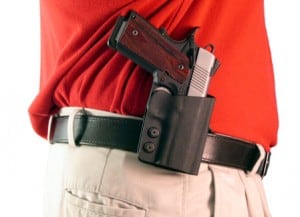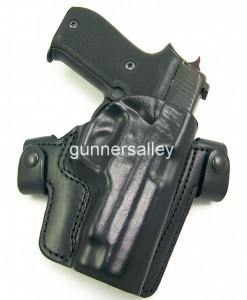Over the last 13+ years that we’ve been in business, we’ve had the opportunity to meet and help thousands of customers. Over that time period certain trends and patterns emerge in regards to carrying concealed. In some cases, it’s the same questions asked over and over, while in others, it’s the same issue or challenge that surfaces.
Based on those experiences, I’d like to talk a bit about what I consider to be one of the biggest mistakes or struggles in CCW. One that tends to have a domino-like effect and create more problems or issues long term. That mistake centers around the choice of handgun for CCW. Not the choice of brand or caliber or style, but the overall choice itself. What I’m mainly talking about is the overall size of the weapon. The size of the weapon will/can play a role in a number of factors including:
Comfort – It’s hard to carry a larger handgun concealed, and be comfortable doing it. Smaller guns take up less space and are usually more comfortably to carry. If the gun/holster combination isn’t comfortable, then I’m betting you won’t carry it very long.
Concealment – A simple concept in that smaller guns = less mass, so they are easier to conceal. In addition to being easier to conceal in the traditional sense (IWB), smaller guns also offer possible carry options like pocket and ankle carry that can’t be done (at least not well) with a larger pistol.
There are other aspects to considered to like body type. A larger person has more space on the their body to conceal a large handgun versus a smaller person. At my size, (6’2/250), it’s easier for me to conceal a larger framed pistol like a Sig P220 as compared to a 6’2 man weighing 150 pounds.
So how do you avoid this mistake?
Picking the “right” handgun for CCW is always a series of trade-offs:
Smaller framed handguns usually mean a lower round count as compared to a larger framed handgun in the same caliber. Take a full size Sig P226, which holds 16 rounds in the stock magazine and compare it to the smaller Sig P228, which holds 13. You’ve given up 3 rounds in capacity, but the 228 is easier to conceal and weights less versus the 226. The question really becomes would you rather have a pistol you can comfortably carry with only 6 shots or a larger handgun that you don’t carry because it’s too heavy? I’ll take the 6 anytime over nothing.
Moving up in caliber almost always means a reduction in round capacity or an increase in weapon size. Now this isn’t an absolute, but typically when you move up in caliber from something like a 9mm to a .40 cal, you’ll lose a round or two in magazine capacity. Move from a .40 cal to a .45 ACP and it will depend on the magazine being a single or double stack. The question to decide here is what’s enough caliber for you and enough round count? Keep in mind that statistics from the FBI related to law enforcement shooting situations shows that the common range is 21 feet or less and an average of 4 rounds are discharged by the officer.
I’ve always been an advocate of practicality. Would I prefer to carry a larger pistol with higher capacity? Sure as you never know kind of situation you’ll encounter. However, from a CCW perspective it really isn’t a practical solution. I’d rather give up a higher caliber or round count, or both; in favor of a reliable weapon that I can comfortably carry and conceal. Does this mean I prefer to carry a .22 derringer? No, I personally don’t carry anything less than a .380, but that’s a personal preference. I think there’s a balance that needs to be reached between:
- Caliber
- Overall size
- Round capacity
By choosing a handgun that is appropriately sized for concealment, you greatly increase the chances that you will actually carry the weapon on a regular basis.




need 3 holsters; iwb,owb,ankle
Right on…I carry a compact storm 9 . Use two different holsters ,in / out of waist depends on what I’m doing. I’m 5’10” about 175. It fits nice. Good report
You are 100% correct. I prefer a medium sized pistol (and like a full size) but I usually carry the smaller Ruger LC9 (this one is lightest and a hair smaller) or Springfield XDs .45—both have been accurate and reliable for me. One can fault anything and they also have drawbacks. But like you say, “6 is better than nothing.”
I really buy into the adage that if it is not comfortable, I won’t carry. I am a medium build (5′-11″, 180#). The best decision was to go to a single stack 9MM. I chose the Taurus 709 slim w/ Pearce mag ext. It has an 8 round capacity. I have used several holsters, but by far my favorite is the Black Hawk appendix carry IWB. It is basically impossible to see my weapon, shirt tucked or out. I drive 8-10 hours and not realize it is there. Carrying in any other location is either uncomfortable or hard to conceal. Carrying appendix carry makes access very easy.
People seem concerned with appendix carry for safety reasons. Although it is not necessary because of the long pull of the Taurus 709 trigger, I use the mechanical safety as well. No time is lost in the draw, because the safety is disengaged while the gun is being drawn after the weapon is in a safe place. Time is not lost in the draw.
The Taurus 709 slim functions with all typed of loads. My carry load is the Federal LE Tactical HST 147 gr. HP. It outperforms all other loads that I have tried. With eight rounds in my hand, I feel more than capable of defending myself and my loved ones. Case closed